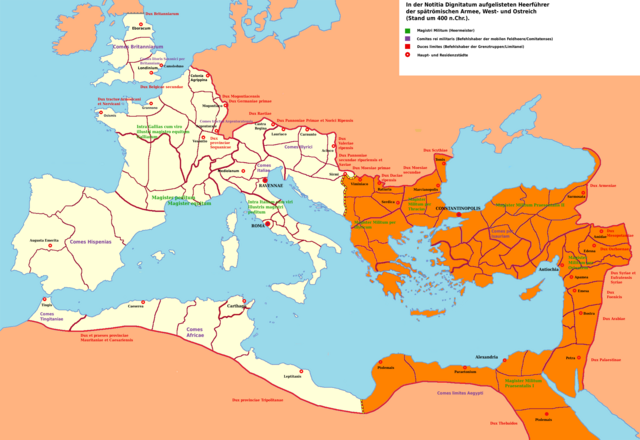Top Qs
Timeline
Chat
Perspective
Dux Mogontiacensis
Western Roman military office From Wikipedia, the free encyclopedia
Remove ads
The Dux Mogontiacensis (English: Commander of the Mainz Region) was a high-ranking officer in the late antique army of the Western Roman Empire and commander-in-chief of the border army (Limitanei) in the province of Germania prima.[1]

Definition, function, and command area

The office is mentioned exclusively in the Notitia dignitatum.[3] The Dux Mogontiacensis was subordinate to the magister peditum praesentalis (commander-in-chief of the infantry) of the Western Empire.[4] At the imperial court, the Dux belonged to the highest rank class of the viri spectabiles. The military district of the Dux Mogontiacensis included the Rhine border between Seltz and Andernach.[1]
Remove ads
Development
Summarize
Perspective
Around the year 300, Diocletian (284–305) reorganized the provinces and separated the civil and military administration. From the middle of the 4th century, there were repeated invasions by the Alamanni, who temporarily occupied areas and garrisons on the left bank of the Rhine.[5] The field army was under the command of the Comes per utramque Germaniam.[6] Initially, the defense of the border in the province of Germania Prima was the responsibility of the Dux Germaniae Primae.[7] Towards the end of the 4th or beginning of the 5th century, his area of command was divided between the Dux Mogontiacensis, who belonged to the Roman knighthood,[8] and the Comes tractus Argentoratensis, with its seat in Mainz and Strasbourg respectively.[9]
From 369 onwards, Emperor Valentinian I (364–375) once again carried out a comprehensive building programme to reinforce the Danube-Iller-Rhine Limes and fortified or rebuilt the garrison sites of the Mainz dukedom. The new Limitan units were detached from infantry legiones palatinae (guards) and comitatenses as well as Auxilia palatina of the Gallic field army and transferred to the Rhine. The individual units had a team strength of about 400 men.[10] According to another view, the Mainz ducat was not established until 396 by Stilicho, on the occasion of a trip to the Rhine[11] or possibly after the Germanic invasion of 406/407.[12]

In older research, the view was mostly held that the Roman border defence in the area of the Mainz ducat had been largely destroyed by the invading Vandals, Alans, and Suevi in 406/407 and that the remaining units were incorporated into the mobile field army. In recent research, some have expressed the opinion that the Roman administration, supported by Burgundian foederates, existed until the middle of the 5th century, until the end of the Western Roman Empire in 476/480.[9]
Remove ads
Administrative staff
The Officium (administrative staff) of the Dux comprised the following offices:[2]
- Princeps ex officiis magistrorum militum praesentalium alternis annis (Head of the Chancellery, appointed annually by the Magister militum)
- Numerarius a parte peditum semper (Treasurer from the army)

- Commentariensis a parte peditum semper (Accountant, legal expert from the army)
- Adiutor (Helper)
- Subadiuva (subordinate helpers)
- Regerendarius (Administration)
- Exceptores (Lawyers)
- Singulares et reliqui officiales (Guard and other officials)
Troops
In addition to the administrative staff, the Dux had eleven prefects and the limitanei units they commanded at his disposal (sub dispositione).[2] The troop list probably represents the number of troops under Constantine III (407–411) or Constantius III (from 412 the actual regent).[12] In addition, there were other forts, such as Alteium (Alzey Castle), in which foederates (allies) were stationed, but these were not included in the Notitia dignitatum[4] as non-Roman or irregular troop units. The origin of the troops – as well as the time of their stationing – is controversial in research.
Remove ads
Distribution of numbers
Summarize
Perspective
The Notitia Dignitatum still contains the old officer ranks and organizational structures from the first Tetrarchy, which remained valid until the collapse of the Western Empire. The following officer rank is listed among the units subordinate to the Dux:[3]
Praefectus (commander): In the late Roman army, this rank referred to both a commander of a cavalry or fleet unit (praefectus classis) and an infantry cohort. In the imperial period, this rank was awarded to the commanders of the auxiliary troop cohorts, while the officers of the cavalry units were referred to as praefecti equitum. In the middle imperial period, a praefectus commanded cavalry units of various strengths, such as ala quingenaria (500 men) and ala miliaria (1000 men), the latter of which was rather rare. In such cases, the praefectus outranked other auxiliary commanders. The rank was usually held by members of the knightly class, who belonged to the Roman upper class and had the necessary wealth and status to command larger contingents of troops.[3]
During the chaotic conditions in the middle of the 3rd century, aristocrats were removed from military positions. Instead of the senatorial legati, the legions were now commanded by a praepositus agentes vice legati or praefectus legionis, and now men from lower social classes could also be promoted. The military rank was abolished in the late 4th century AD when the Roman army was reorganized once again. Praefecti then served, among other things, as quartermasters general at the court of the emperor. Under Constantine I (312–337), the four praetorian prefects were also relieved of their military functions, but they retained their judicial and financial responsibilities and were among the highest officials of the imperial administration.[3]
According to the ND Occ. the Dux had the following units at his disposal:[13]
Remove ads
Epigraphic sources
While the Notitia dignitatum is the only source for the Dux Mogontiacensis, the Acincenses, Martenses, Menapii, Secundani and Vindices are also epigraphically attested by brick stamps. In addition, two troop names have been preserved on stamps whose names do not appear in the list of the Mainz Dux: the Cornacenses and a unit stamped with Portis, and whose name is dissolved with Milites Portisienses. The Legio XXII Primigenia, which is not mentioned in the Notitia, also bricked in the area of the Mainz ducat in late antiquity.[24]
Remove ads
External links
References
Bibliography
Wikiwand - on
Seamless Wikipedia browsing. On steroids.
Remove ads







